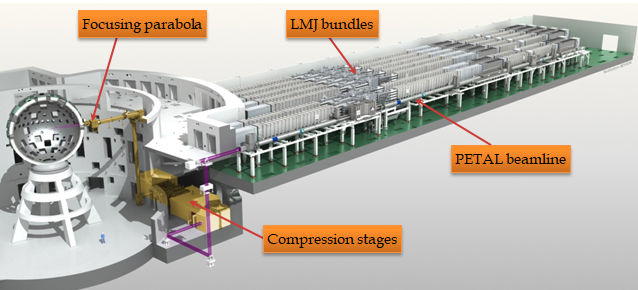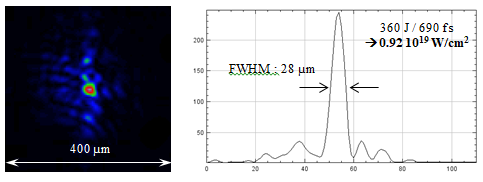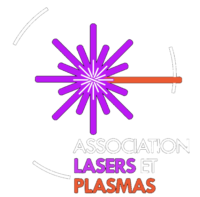Rationale
The PETAL project has developed and coupled to LMJ an additional high-energy multi-Petawatt beam. This project has been performed by the CEA under the financial auspices of the Nouvelle Aquitaine Region (“maître d’ouvrage”, project owner), of the French Government and of the European Union.
PETAL provides a combination of a very high intensity beam, synchronized with the high energy nanosecond beams of LMJ; it expands the LMJ experimental field on High Energy Density Physics.
LMJ-PETAL is an exceptional tool for academic research, offering the opportunity to study matter in extreme conditions.
Beam characteristics
PETAL is a short-pulse (500 fs to 10 ps) ultra-high-power (PW), high-energy beam (kJ).
The PETAL design is based on the Chirped Pulse Amplification (CPA) technique combined with Optical Parametric Amplification (OPA). Moreover, it benefits from the laser developments made for the high-energy LMJ facility allowing it to reach the kilojoules level.
The PETAL beamline occupies the place of a LMJ bundle in the South-East laser bay. The compressor stages are located at the bottom level of the target bay, and after a transport under vacuum, the beam is focused in the equatorial plane of the LMJ chamber via an off-axis parabolic mirror.

The front end is based on a fs oscillator with pulses sent in an Offner stretcher (up to 9 ns). Then a Pre-Amplifier Module (PAM), including OPA stages and pump laser, delivers a 100 mJ amplified signal pulse.
The PETAL amplifier section (same architecture as the LMJ amplifier section but with chromatism corrections) delivers up to 6 kJ.
The compression scheme is a two-stage system. The first compressor, in air atmosphere, reduces the pulse duration to 350 ps. The initial beam is divided into 4 sub-apertures which are independently compressed and synchronized into the second compressor under vacuum. The pulse duration is adjustable from 0.5 to 10 ps. The 4 sub-apertures are coherently combined with a segmented mirror between the two stages.
Due to the current transport mirrors damage threshold, the available energy on target is limited at a ~500 J level. Developments on new technologies are under progress to reach the kJ level.
A pulse duration down to 570 fs has been obtained, which corresponds to a potential power of 1.8 PW for a full energy shot.
Some test shots with longer pulse duration (10 ps) have been successfully performed.
The temporal contrast of the pulse has been characterized; on a long time scale (10 ns) the energy contrast is 10-3, and on a short time scale (250 ps) the power contrast is around 10-6. The focal spot has a better than 30 µm Full Width at Half Max, leading to a 1019 W/cm2 intensity.

Governance
The operation of PETAL takes place within the framework of a «Tripartite Convention relating to the operation of PETAL laser by the CEA», established between the French State, the Nouvelle-Aquitaine Region and the CEA. PETAL governance is provided by a Strategic (Executive) Committee and a Technical (Steering) Committee.
The Strategic Committee is responsible for ensuring that the operation of PETAL is consistent with the objectives set by the Convention ; for deciding on any requests for infrastructure developments from PETAL users ; and for reviewing and validating the method of financing selected developments.
The Strategic Committee is composed of :
- the Prefect of the Nouvelle-Aquitaine Region, or his representative;
- the President of the Regional Council of Nouvelle-Aquitaine, or his representative;
- the Director of Military Applications of the CEA, or his representative;
- the Director of the CESTA CEA center, or his representative;
- and permanent guest members.
The Technical Committee is responsible for ensuring the proper operation of PETAL and maintaining the quality of PETAL’s performance, and for evaluating the annual review of PETAL’s operation and experiments carried out.
The Technical Committee is composed of :
- the CEA Project Leader for Plasma and Laser Experimental Validation;
- a representative of the Region;
- experts representing the scientific community (ALP).
Chronicle
The PETAL project started in 2005. The first five years was dedicated to the demonstration of feasibility on the LIL (Laser Integration Line) facility.
In 2010 it was decided to couple PETAL with LMJ facility. PETAL and LMJ have been modified to comply with each other.
The commissioning of PETAL with broadband spectrum pulses began in 2015.
In May 2015, PETAL delivered 850 J in 0.7 ps corresponding to a peak power of 1.2 PW. PETAL became the most powerful laser beam in the world, in the high energy lasers category.
In December 2015 the first associated LMJ and PETAL laser shot in the LMJ target chamber was performed.
In March 2016, PETAL was included in the national roadmap for major Research Infrastructures.
After Nuclear Safety authorization, the first shot on target was performed in October 2017, and the first use for academic experiment occurred in December 2017.
| Events | Date |
| Beginning of PETAL | 2005 |
| Decision of coupling PETAL with LMJ | 2010 |
| PETAL most powerful laser beam with 1.2 PW | 2015 |
| First associated LMJ and PETAL shot | 2015 |
| PETAL in the roadmap for major Research Infrastructures | 2016 |
| First PETAL test shots on target | 2017 |
| First academic experiments on LMJ with 4 quads and PETAL | 2017 |
Further developments are under progress to increase the energy on target and to improve the temporal contrast.
More information is avalable in the User-guide.
